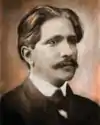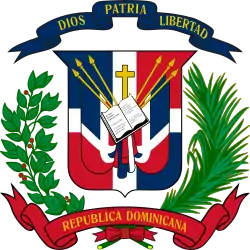Francisco Henríquez y Carvajal
Francisco Hilario Henríquez y Carvajal (14 January 1859 – 6 February 1935)[1] was a doctor, lawyer, writer, educator and politician from the Dominican Republic, who served as president just prior to the US occupation of the country. He married Salomé Ureña. He had 4 children, Pedro, Francisco, Max, and Camila.

Life and career
Henríquez was born in Santo Domingo, to a family descended from Sephardic Jews who immigrated in the 19th century from Curaçao from the Netherlands .[2][3] After studying extensively in his homeland, beginning in 1887, Henríquez moved to Paris for four years, earning a doctorate in Medicine the University of Paris. He returned to the Dominican Republic, where he practiced medicine and taught. He served as editor of the newspaper El Maestro, but left the country during the dictatorship of Ulises Heureaux. While away, he befriended Juan Isidro Jiménez and returned to the Dominican Republic in 1899 to serve as Minister of Foreign Affairs when Heureaux was assassinated and Jiménez was made president.
Following the fall of Jiménez in 1902, Henríquez established residence in Cuba and practiced medicine. He returned briefly to his country of birth following the interim government of Horacio Vásquez in 1903, but he left several months later. In 1907, President Ramón Cáceres sent him as a delegate to the Hague Convention. In 1911 Henríquez served as an emissary to Haiti following border disputes.
In 1916, Henríquez was on a diplomatic mission when he learned that the Dominican Republic had been occupied by the United States. The Council of Secretaries of State led by Horacio Vásquez elected Henríquez President.[4][5] He served from 31 July to 29 November 1916.[6] His successor was United States military governor Harry Shepard Knapp.
During the presidency of Rafael Leonidas Trujillo Molina, he served as envoy in France and Cuba from 1930 to 1935.
Death
Francisco Henríquez y Carvajal died in Santiago de Cuba, Cuba in 1935 at the age of 76.
Selected publications
- "La hija del Hebreo" (1883, 'The daughter of the Hebrews')
- "Ramón Mella" (1891)
- "Informe sobre la seguridad Conferencia Internacional Americana" (1902,' Report on the American International Security Conference ')
- "Juvenilia" (1904)
- "Dolorosa" (1909,' Painful ')
- "Derecho Internacional Público y la Guerra" (1915)
- "Discurso pro-Pablo Duarte" (1915,' Speaking for Pablo Duarte ')
- "Páginas Selectas" (1918,'Selected Writings')
- "Cuba y Quisqueya" (1920, 'Cuba and Quisqueya ')
- "Rosa de la tarde" (1923, 'Rose of the Afternoon')
- "Guarocuya. Monólogo de Enriquillo El" (1924, 'Guarocuya. The monologue of Enriquillo')
- "Todo por Cuba" (1925, 'All of Cuba')
- "Nacionalismo" (1925, 'nationalism')
- "Del Amor y del Dolor" (1926, 'About love and about pain')
- "Páginas electas" (1926, 'Selected Writings')
- "Mi Álbum de Sonetos "(1927, 'My album of the sonnets')
- " Etica y Estética "(1929, 'ethics and aesthetic')
- " historicos Romances "(1937, 'Historical romances')
- Bani "(1939)
- " El poema de la historia. fragmento de un poema inconcluso "(1948, 'The poetry of history. fragment of an unfinished poem')
- " Cuentos "(1950, 'narratives')
References
- Mendez, Serafín Mendez and Gail Cueto (2003). Notable Caribbeans and Caribbean Americans: a biographical dictionary. Greenwood Publishing Group, ISBN 978-0-313-31443-8
- Archived 13 January 2008 at the Wayback Machine Biography of Francisco Henríquez y Carvajal (in Spanish)
- Read, Jaime (23 August 2010). "Familias capitaleñas: Los Henríquez". Cápsulas Genealógicas (in Spanish). Santo Domingo: Hoy (1/3). Retrieved 3 February 2014.
Este apellido se origina en la península Ibérica, tanto en Portugal como en España, de familias judías sefardíes que marcharon posteriormente hacia el norte, llegando a Holanda, a raíz de la expulsión de judíos luego de la Reconquista. De allí parten hacia las colonias neerlandesas del Caribe, llegando a Curazao. En la República Dominicana, el tronco de esta familia fue Noel Henríquez Altías (n. 25 diciembre de 1813), natural de Curazao
- Staff report (18 May 1916). NEW DOMINICAN PRESIDENT.; Chamber of Deputies Elects Abreu; Senate Expected to Confirm.New York Times
- Staff report (10 June 1916). Sees us at fault in Santo Domingo; Former Receiver General of Customs There Blames the Administration. Charges Public Deception. Says the "Ostrich-like" Policy of the United States Has Finally Resulted in the Spilling of Blood. New York Times
- Staff report (28 July 1916). DR. CARVAJAL LEAVES CUBA.; Sails for Santo Domingo to Take Office as President. New York Times
External links
| Political offices | ||
|---|---|---|
| Preceded by Council of Secretaries of State |
President of the Dominican Republic 1916 |
Succeeded by United States occupation |
